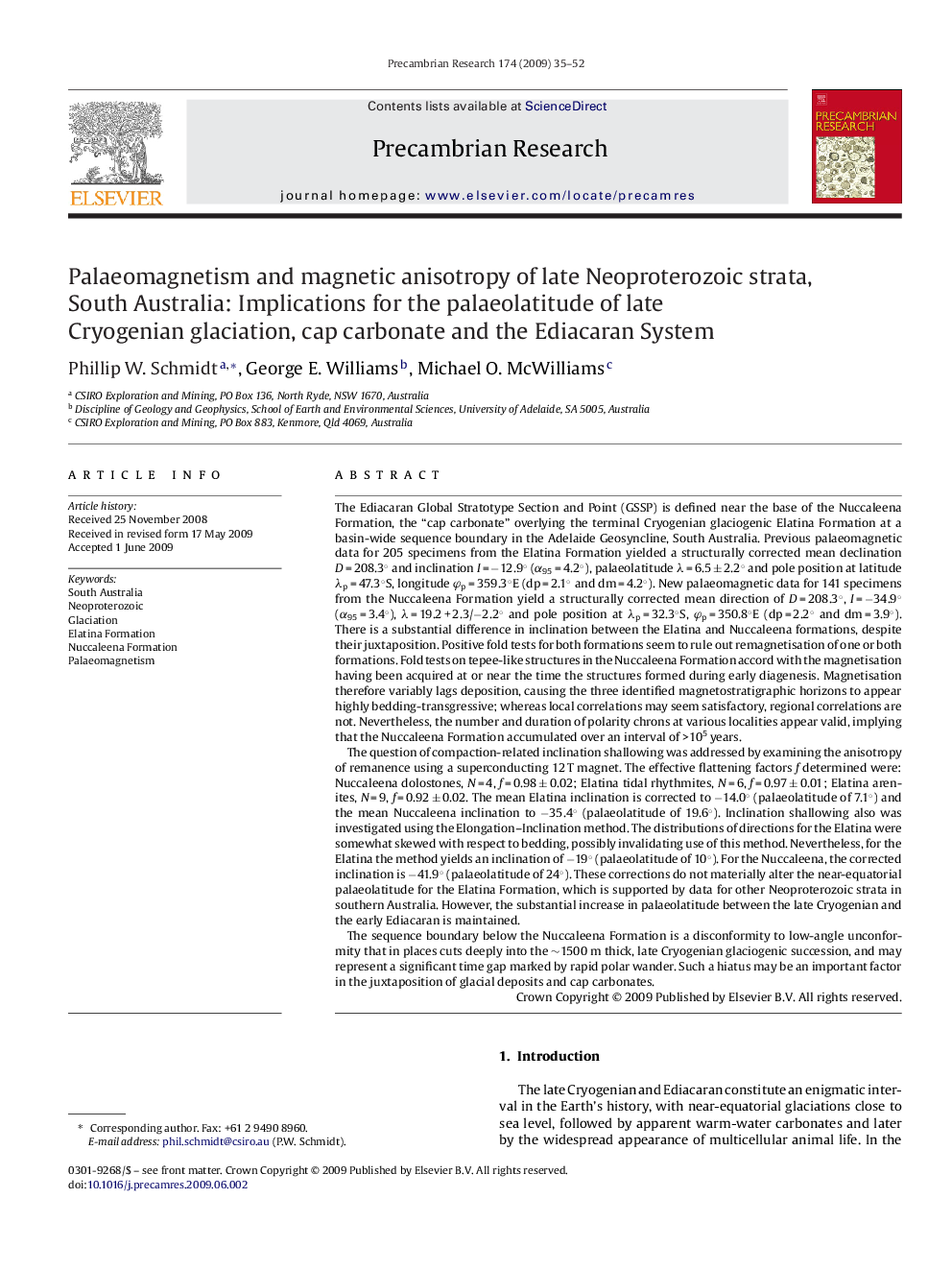| کد مقاله | کد نشریه | سال انتشار | مقاله انگلیسی | نسخه تمام متن |
|---|---|---|---|---|
| 4723947 | 1639686 | 2009 | 18 صفحه PDF | دانلود رایگان |

The Ediacaran Global Stratotype Section and Point (GSSP) is defined near the base of the Nuccaleena Formation, the “cap carbonate” overlying the terminal Cryogenian glaciogenic Elatina Formation at a basin-wide sequence boundary in the Adelaide Geosyncline, South Australia. Previous palaeomagnetic data for 205 specimens from the Elatina Formation yielded a structurally corrected mean declination D = 208.3° and inclination I = −12.9° (α95 = 4.2°), palaeolatitude λ = 6.5 ± 2.2° and pole position at latitude λp = 47.3°S, longitude φp = 359.3°E (dp = 2.1° and dm = 4.2°). New palaeomagnetic data for 141 specimens from the Nuccaleena Formation yield a structurally corrected mean direction of D = 208.3°, I = −34.9° (α95 = 3.4°), λ = 19.2 + 2.3/−2.2° and pole position at λp = 32.3°S, φp = 350.8°E (dp = 2.2° and dm = 3.9°). There is a substantial difference in inclination between the Elatina and Nuccaleena formations, despite their juxtaposition. Positive fold tests for both formations seem to rule out remagnetisation of one or both formations. Fold tests on tepee-like structures in the Nuccaleena Formation accord with the magnetisation having been acquired at or near the time the structures formed during early diagenesis. Magnetisation therefore variably lags deposition, causing the three identified magnetostratigraphic horizons to appear highly bedding-transgressive; whereas local correlations may seem satisfactory, regional correlations are not. Nevertheless, the number and duration of polarity chrons at various localities appear valid, implying that the Nuccaleena Formation accumulated over an interval of >105 years.The question of compaction-related inclination shallowing was addressed by examining the anisotropy of remanence using a superconducting 12 T magnet. The effective flattening factors f determined were: Nuccaleena dolostones, N = 4, f = 0.98 ± 0.02; Elatina tidal rhythmites, N = 6, f = 0.97 ± 0.01; Elatina arenites, N = 9, f = 0.92 ± 0.02. The mean Elatina inclination is corrected to −14.0° (palaeolatitude of 7.1°) and the mean Nuccaleena inclination to −35.4° (palaeolatitude of 19.6°). Inclination shallowing also was investigated using the Elongation–Inclination method. The distributions of directions for the Elatina were somewhat skewed with respect to bedding, possibly invalidating use of this method. Nevertheless, for the Elatina the method yields an inclination of −19° (palaeolatitude of 10°). For the Nuccaleena, the corrected inclination is −41.9° (palaeolatitude of 24°). These corrections do not materially alter the near-equatorial palaeolatitude for the Elatina Formation, which is supported by data for other Neoproterozoic strata in southern Australia. However, the substantial increase in palaeolatitude between the late Cryogenian and the early Ediacaran is maintained.The sequence boundary below the Nuccaleena Formation is a disconformity to low-angle unconformity that in places cuts deeply into the ∼1500 m thick, late Cryogenian glaciogenic succession, and may represent a significant time gap marked by rapid polar wander. Such a hiatus may be an important factor in the juxtaposition of glacial deposits and cap carbonates.
Journal: Precambrian Research - Volume 174, Issues 1–2, October 2009, Pages 35–52